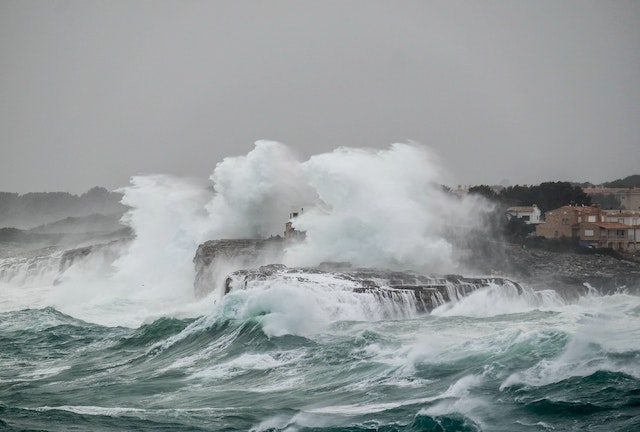
What causes a tsunami? A very large and very sudden displacement of the ocean.
A tsunami is a series of waves that are caused by a huge amount of water in the ocean suddenly being moved. It is different to a regular wave because the wave goes deep into the ocean. The word tsunami is Japanese in origin. “Tsu” means harbor and “nami” means wave. The word came into English in 1896 when the National Geographic used it to explain a wave caused by an earthquake that had just hit Japan.
Tsunamis are caused by a sudden movement of ocean water, but there are different ways the water can be moved. A study of tsunamis showed that 72% of tsunamis were caused by earthquakes. The cause of 11% was unknown. 10% were caused by landslides. 5% were caused by volcanoes and 2% were caused by meteors.
An earthquake can cause a tsunami by moving the seabed. The Earth’s tectonic plates are constantly moving and when the pressure builds up they can suddenly be pushed up or down. These areas are called subduction zones and they are around the Pacific Ring of Fire. There are major subduction zones close to Chile, Alaska, Japan, and Indonesia. Two plates meet under the sea and the lighter plate is forced up by the heavier one. The tension builds until the plate suddenly snaps up, lifting the column of seawater above it up. The column of water rises out of the ocean and then drops back, starting a wave. Not every undersea earthquake will cause a tsunami. The earthquake has to be stronger than a magnitude of 6.5. It must happen at a depth of less than 70km and it must cause the water to move upwards. If all of these criteria are met, a tsunami can result.
Landslides that cause tsunamis can occur above the water or underneath it. A large amount of material suddenly slips into the sea, displacing the water, and causing a wave. The volcanoes that cause landslides are usually under the water and the eruption pushes the water up. If the volcano then collapses, Meteors that cause tsunamis are relatively rare, but they do happen. These types of tsunamis tend to be less powerful than a tsunami caused by an earthquake.
So, what is a tsunami? It is a wave, but it is not the same as an ordinary wave. Most of the waves we see on the sea are caused by the wind. The friction of the wind pushes the surface of the water and makes waves. The waves keep going until the wind stops and they lose their energy. They have a wavelength of about 100 m and they only extend about 50 m under the surface. (The wavelength is the distance between the peaks of a wave.) Tsunamis are different to this. The tsunami wave travels through the water and not on top of it. The wave extends down to the sea floor and the wavelength can be over 200 km. A boat on the ocean won’t notice a tsunami if it passes under them because it only extends a little bit out of the sea. All of the motion is under the water.
The tsunami is the result of the transfer of energy from the tectonic plate that shifted to the water. Water can transfer energy very efficiently, which is why the speed of sound in water is much higher than it is in air. The energy moves away from the epicenter of the earthquake in a circle and its speed is directly related to the depth of the water. The deeper the water, the faster it will travel. If the ocean is 7000 m deep, the wave will travel at 943 km/h. At 4000 m (the average depth of the Pacific) it will travel at 713 km/h. As the wave approaches the shore and the ocean gets shallower, the wave loses energy and slows down.
The problem for us with tsunamis comes when they hit the shore. As the ocean gets shallower, their speed decreases, their wavelength decreases, but their height increases. This is called wave shoaling. As the waves get larger, water is drawn away from the beach to fill the void and feed the wave. A sure sign that a tsunami is coming is the sea suddenly pulling very far out. When the tsunami hits the shore, the wave is still carrying a lot of energy, and the sheer volume of water can push the wave up to 16 km inland before it recedes. A tsunami usually consists of more than one wave, and it can take hours for all of the waves to reach the shore. The first wave isn’t always the largest.
So, many different things can cause a tsunami, but earthquakes on the seabed are the most common cause. And this is what I learned today.
Sources
https://oceanservice.noaa.gov/facts/wavesinocean.html
https://www.noaa.gov/education/resource-collections/ocean-coasts/tsunamis
https://www.ngdc.noaa.gov/hazard/tsunami-db-intro.html
http://itic.ioc-unesco.org/index.php?option=com_content&view=article&id=1164&Itemid=2031
https://science.howstuffworks.com/nature/natural-disasters/tsunami3.htm
https://www.npr.org/2011/03/18/134600508/history-of-tsunami-the-word-and-the-wave
https://en.wikipedia.org/wiki/Tsunami
http://tsunami.org/what-causes-a-tsunami/
